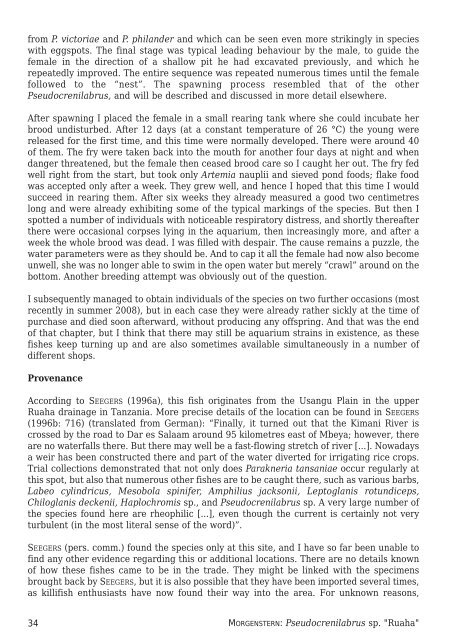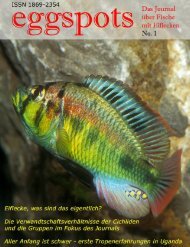Eggspots Elsewhere - Welt der Fische / World of Fishes
Eggspots Elsewhere - Welt der Fische / World of Fishes
Eggspots Elsewhere - Welt der Fische / World of Fishes
You also want an ePaper? Increase the reach of your titles
YUMPU automatically turns print PDFs into web optimized ePapers that Google loves.
from P. victoriae and P. philan<strong>der</strong> and which can be seen even more strikingly in species<br />
with eggspots. The final stage was typical leading behaviour by the male, to guide the<br />
female in the direction <strong>of</strong> a shallow pit he had excavated previously, and which he<br />
repeatedly improved. The entire sequence was repeated numerous times until the female<br />
followed to the “nest”. The spawning process resembled that <strong>of</strong> the other<br />
Pseudocrenilabrus, and will be described and discussed in more detail elsewhere.<br />
After spawning I placed the female in a small rearing tank where she could incubate her<br />
brood undisturbed. After 12 days (at a constant temperature <strong>of</strong> 26 °C) the young were<br />
released for the first time, and this time were normally developed. There were around 40<br />
<strong>of</strong> them. The fry were taken back into the mouth for another four days at night and when<br />
danger threatened, but the female then ceased brood care so I caught her out. The fry fed<br />
well right from the start, but took only Artemia nauplii and sieved pond foods; flake food<br />
was accepted only after a week. They grew well, and hence I hoped that this time I would<br />
succeed in rearing them. After six weeks they already measured a good two centimetres<br />
long and were already exhibiting some <strong>of</strong> the typical markings <strong>of</strong> the species. But then I<br />
spotted a number <strong>of</strong> individuals with noticeable respiratory distress, and shortly thereafter<br />
there were occasional corpses lying in the aquarium, then increasingly more, and after a<br />
week the whole brood was dead. I was filled with despair. The cause remains a puzzle, the<br />
water parameters were as they should be. And to cap it all the female had now also become<br />
unwell, she was no longer able to swim in the open water but merely “crawl” around on the<br />
bottom. Another breeding attempt was obviously out <strong>of</strong> the question.<br />
I subsequently managed to obtain individuals <strong>of</strong> the species on two further occasions (most<br />
recently in summer 2008), but in each case they were already rather sickly at the time <strong>of</strong><br />
purchase and died soon afterward, without producing any <strong>of</strong>fspring. And that was the end<br />
<strong>of</strong> that chapter, but I think that there may still be aquarium strains in existence, as these<br />
fishes keep turning up and are also sometimes available simultaneously in a number <strong>of</strong><br />
different shops.<br />
Provenance<br />
According to SEEGERS (1996a), this fish originates from the Usangu Plain in the upper<br />
Ruaha drainage in Tanzania. More precise details <strong>of</strong> the location can be found in SEEGERS<br />
(1996b: 716) (translated from German): “Finally, it turned out that the Kimani River is<br />
crossed by the road to Dar es Salaam around 95 kilometres east <strong>of</strong> Mbeya; however, there<br />
are no waterfalls there. But there may well be a fast-flowing stretch <strong>of</strong> river [...]. Nowadays<br />
a weir has been constructed there and part <strong>of</strong> the water diverted for irrigating rice crops.<br />
Trial collections demonstrated that not only does Parakneria tansaniae occur regularly at<br />
this spot, but also that numerous other fishes are to be caught there, such as various barbs,<br />
Labeo cylindricus, Mesobola spinifer, Amphilius jacksonii, Leptoglanis rotundiceps,<br />
Chiloglanis deckenii, Haplochromis sp., and Pseudocrenilabrus sp. A very large number <strong>of</strong><br />
the species found here are rheophilic [...], even though the current is certainly not very<br />
turbulent (in the most literal sense <strong>of</strong> the word)”.<br />
SEEGERS (pers. comm.) found the species only at this site, and I have so far been unable to<br />
find any other evidence regarding this or additional locations. There are no details known<br />
<strong>of</strong> how these fishes came to be in the trade. They might be linked with the specimens<br />
brought back by SEEGERS, but it is also possible that they have been imported several times,<br />
as killifish enthu siasts have now found their way into the area. For unknown reasons,<br />
34 MORGENSTERN: Pseudocrenilabrus sp. "Ruaha"




